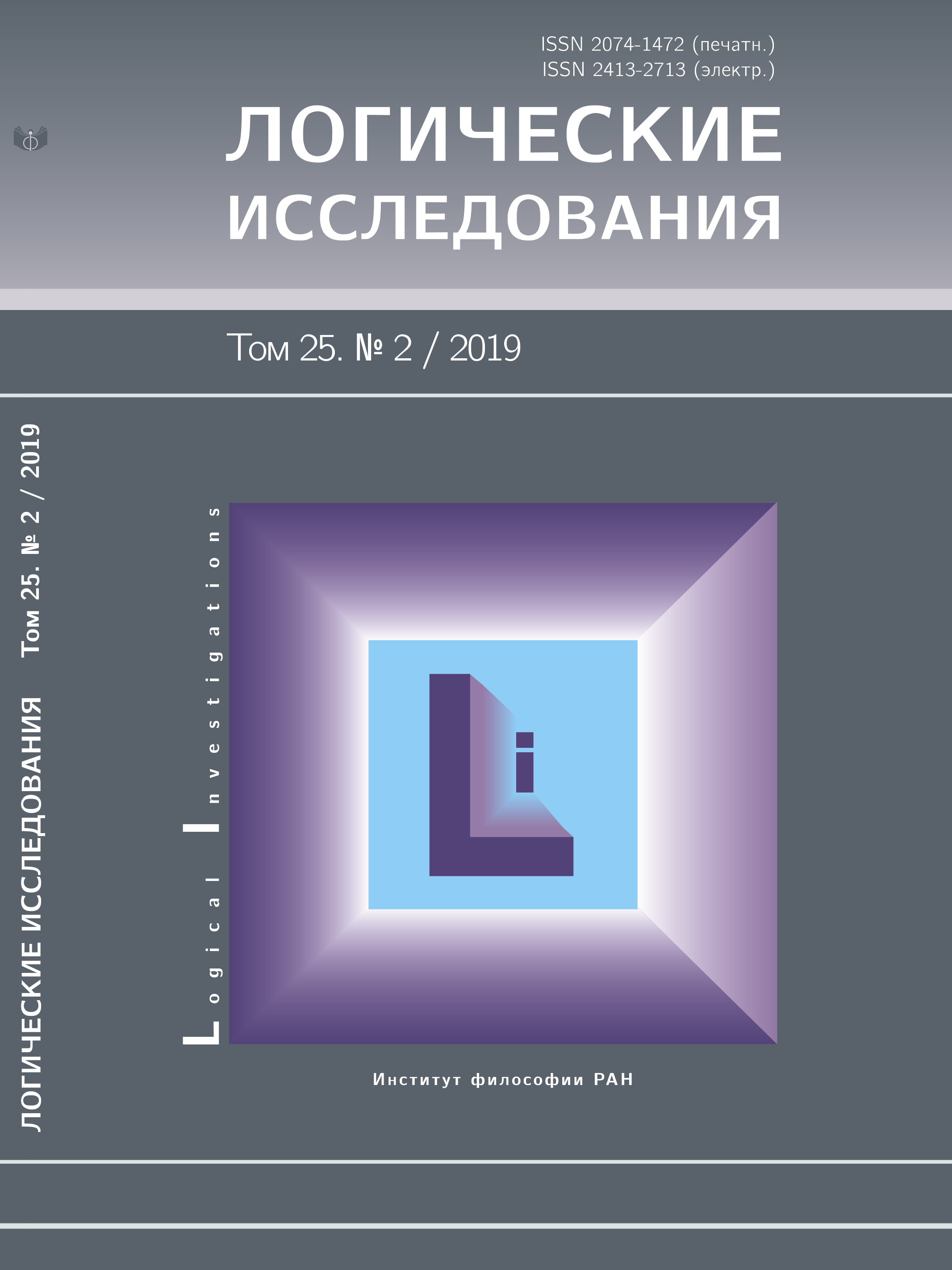Peirce's thesis: logical analysis and ontological consequences
##plugins.themes.bootstrap3.article.main##
Abstract
C. Peirce put forward the hypothesis that any relations can be reduced to relations whose arity does not exceed three. This hypothesis is closely related to the basic categories of his phenomenology.
In the paper we provide semantic analysis and detailed proof of the following two results.
1. Any first-order theory can be represented in a language containing a finite set of one-place functional symbols. A philosophically important consequence of this is the same expressive power of relational and functional languages and corresponding ontologies.
2. Any first-order theory can be represented in a language containing a single three-place predicate symbol $ U $ and a finite set of individual constants. This confirms Peirce's conjecture about the fundamental role that three-place relationships play. A language whose descriptive symbols contain only individual constants and the only three-place predicate turns out to be a universal language for representing any first-order theories.
There is a structural similarity between the three-place predicate $ U(e,u,x) $ and the three-place predicate $ UM(e,u,x) $, which represents the universal Turing machine. Both can be considered as containers of one-place functions. From this point of view, the predicate $ U $ is an extension of the predicate $ UM $ to any, and not only effectively computable functions.
Proved theorems force us to take a fresh look at many physical theories.
In the theory of relativity, the four-dimensional Minkowski space-time is considered as the fundamental structure, which can be represented as a four-place predicate $ S(x,y,z,t) $. It~follows from the theorem on the existence of the predicate $ U(e,u,x) $ that the four-dimensional Minkowski space-time is not a fundamental physical structure, since it can be reduced to a single three-place relation.
##plugins.generic.usageStats.downloads##
##plugins.generic.usageStats.noStats##
##plugins.themes.bootstrap3.article.details##
How to Cite
Shalack V. I. Peirce’s thesis: logical analysis and ontological consequences // Logicheskie Issledovaniya / Logical Investigations. 2019. VOL. 25. № 2. C. 138-163.
Issue
Section
Philosophy and Logic
Copyright (c) 2019 Владимир Иванович Шалак

This work is licensed under a Creative Commons Attribution-NonCommercial 4.0 International License.
References
Вайнберг С. Мечты об окончательной теории. Физика в поисках самых фундаментальных законов природы. 2-е изд. М.: Едиториал УРСС, 2004. 256 с.
Карнап Р. Старая и новая логика // Журнал "Erkenntnis" ("Познание"). Избранное. М.: Издательский дом "Территория будущего", Идея-Пресс, 2007. С. 105–119.
Мендельсон Э. Введение в математическую логику. М.: Наука, 1976. 320 с.
Пирс Ч.С. Рассуждение и логика вещей. Лекции для Кембриджских конференций 1898 года. М.: РГГУ, 2005. 371 с.
Смирнов В.А. Логические методы анализа научного знания. М.: Наука, 1987. 256 с.
Хокинг С. Теория всего. М.: АСТ, 2018. 160 с.
Шалак В.И. Логика функций vs логика отношений // Логические исследования. Вып. 16. М.: Наука, 2010. С. 259–271.
Church A., Quine W. Some Theorems on Definability and Decidability // The Journal of Symbolic Logic. 1952. Vol. 17. No. 3. P. 179–187.
Herzberger H.G. Peirce’s Remarkable Theorem // Pragmatism and Purpose. Toronto: Toronto University Press, 1981. P. 41–58.
Kleinert E. On the Reducibility of Relations: Variations on a Theme of Peirce // Transactions of the Charles S. Peirce Society. 2007. Vol. 43. No. 3 (Summer, 2007). P. 509–520.
Skidmore A. Peirce \& Triads // Transactions of the Charles S. Peirce Society. 1971. Vol. 7. No. 1 (Winter, 1971). P. 3–23.
Карнап Р. Старая и новая логика // Журнал "Erkenntnis" ("Познание"). Избранное. М.: Издательский дом "Территория будущего", Идея-Пресс, 2007. С. 105–119.
Мендельсон Э. Введение в математическую логику. М.: Наука, 1976. 320 с.
Пирс Ч.С. Рассуждение и логика вещей. Лекции для Кембриджских конференций 1898 года. М.: РГГУ, 2005. 371 с.
Смирнов В.А. Логические методы анализа научного знания. М.: Наука, 1987. 256 с.
Хокинг С. Теория всего. М.: АСТ, 2018. 160 с.
Шалак В.И. Логика функций vs логика отношений // Логические исследования. Вып. 16. М.: Наука, 2010. С. 259–271.
Church A., Quine W. Some Theorems on Definability and Decidability // The Journal of Symbolic Logic. 1952. Vol. 17. No. 3. P. 179–187.
Herzberger H.G. Peirce’s Remarkable Theorem // Pragmatism and Purpose. Toronto: Toronto University Press, 1981. P. 41–58.
Kleinert E. On the Reducibility of Relations: Variations on a Theme of Peirce // Transactions of the Charles S. Peirce Society. 2007. Vol. 43. No. 3 (Summer, 2007). P. 509–520.
Skidmore A. Peirce \& Triads // Transactions of the Charles S. Peirce Society. 1971. Vol. 7. No. 1 (Winter, 1971). P. 3–23.
